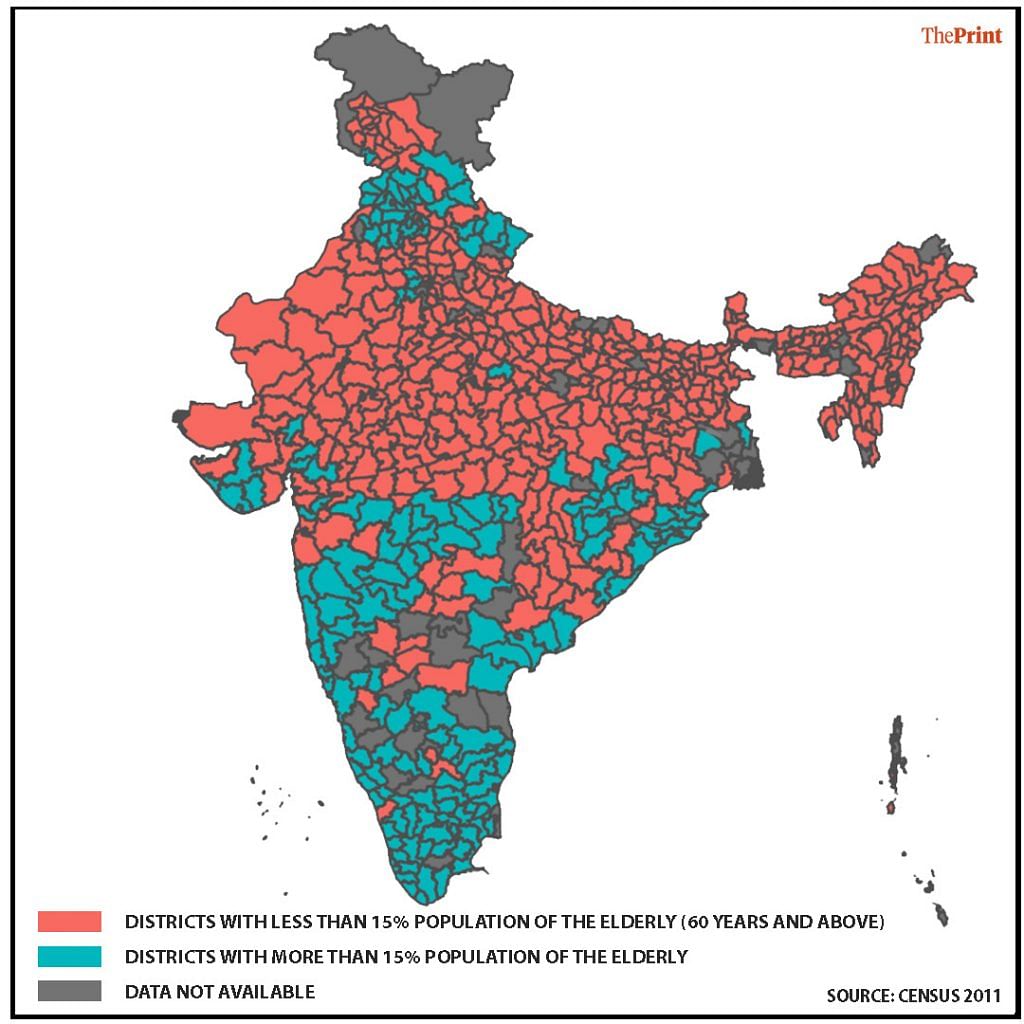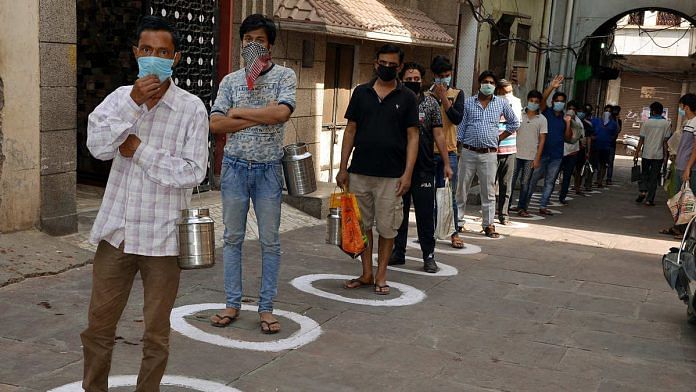The government has announced it is lifting the lockdown in many sectors, and India’s working population, the youngest in the world, will not only be able to put the economy back on track, but will also be our warriors in the fight against Covid-19.
After sectoral easing, India now has to plan how to ease the lockdown for sectors such as retail and informal workers. A critical component of getting the economy back on its feet is to plan to get consumers to step out of their houses. Again, India’s young population will be its greatest asset.
Also read: Faced with Covid-19, India chose to protect lives, not livelihoods. And that’s a good thing
Herd immunity
In a recent interview, noted epidemiologist Dr Jayaprakash Muliyil made a case for a strategy for acquiring herd immunity. A lockdown is a way to buy time, but when the lockdown is opened, the virus could emerge again.
Dr Muliyil argues that we should protect the elderly, while sending the young out. If the elderly can be protected for a period of, say, six months, till the virus runs through the young population, they will also be safer, as the virus will not be able to jump from person to person due to lack of susceptible carriers.
Since we cannot stay in lockdown forever, or even for the months it may take for a vaccine to develop, thinking about developing immunity is critical.
We do not know the share of the population, or the threshold, required for acquiring herd immunity from Covid-19. But beyond a point, when most of the young — about 85 percent of the population — have acquired immunity to the virus, there will be no carriers.
Also read: How India can buck the trend of global recession caused by coronavirus
Protecting the elderly will reduce need for critical care
The big question is: Is it possible for India to try to adopt this strategy when countries like the UK tried herd immunity, but then quickly went into lockdown? Yes, because of the difference in the age profile of the population.
While in the UK, Italy and China, the share of the population above 65 is between 20 to 25 per cent, and in the US, about 15 per cent, in India, the share is about 8.5 per cent. Most of the critically ill, as well as most deaths, are in this age category.
The government seems to be thinking along the same lines. In his speech on 14 April, the PM asked people to do seven things. The first of those was to protect the elderly.
In an advisory for senior citizens, the government has projected that there are 16 crore people above 60 years of age in India. The advisory includes dos and don’ts, such as washing hands, avoiding markets and not hugging their loved ones. These can be implemented by rich and poor alike.
India’s main strategy has been to reduce the burden on critical care, India’s most scarce resource. In addition to quarantining and testing patients, protecting the elderly will be an important element of India’s Covid-19 strategy. Once this is done, the need for critical care is expected to be lower.
India’s migrant workers have been quarantined for more than 21 days in densely populated dwellings. They could easily have had exposure to the virus as there was no social distancing among them. There have so far been no reported Covid-19 cases requiring critical care from these mostly young persons with few co-morbidities. In a strategy of easing the lockdown that takes demographics into account, they can be allowed to go back to work.
Also read: Covid-19 with diabetes is more deadly. Here’s why you must control it during lockdown and how
‘Young’ districts can open up faster
A phased strategy of regional removal of lockdown can be prepared based on this framework. Based on Census 2011, we can see the age profile of India’s districts. Today, there are 529 districts in India where 85 per cent of the population is below the age of 60.

Many of these are among the 353 districts identified as the ‘Green Zone’ by the government, where there are no Covid-19 cases. The very large share of the young population of these districts would qualify as those needing least critical care.
Among these districts, the elderly should continue to be protected. In India, the normal retirement age is 60. When offices and workplaces open after the lockdown, they will be populated mainly by the young. Those above 60 can be asked to stay at home. Even those below 60 can be given a choice, especially if they have any co-morbidities. This would help bring the economy back on track. While some among the young will get the virus, the need for critical care is likely to be limited, and we can ensure their recovery.
There are 58 districts in India where the share of the population above 60 is less than 10 per cent. They can be opened up right away. There are a total of 275 districts with less than 12.5 per cent elderly people. That can be the next step. The 529 districts with less than 15 per cent senior citizens can come next.
Most of the districts with the largest share of the elderly are in Kerala, and some in Tamil Nadu. Kerala has one of the best health systems in the country and has so far had a low death rate and high recovery rate.
Another key advantage India has over, say, the UK, whose critical care system got overburdened, is that owing to the early lockdown, people are more aware about the virus and will be more likely to observe precautions. At the end of the day, maintaining personal distance, washing hands, wearing masks for the elderly is something that only families and individuals can implement.
The overriding question today is how people can start earning their living while the hospitals in India can cope and lives can be saved. The longer-term question is to defeat the coronavirus by acquiring immunity against it. In the absence of a vaccine, the young are India’s corona soldiers. Their immunity will prevent the spread of the virus.
The author is an economist and a professor at the National Institute of Public Finance and Policy. Views are personal.
Also read: No matter how you look at it, India’s lockdown-2 can cost as many lives as it will save




The young might be less susceptible to dying but are not less likely to contract the disease. Many of them will be asymptomatic carriers and will silently spread the disease
Besides, exposing such a large cohort to even a low risk of death means that in absolute numbers, there will be lots of young people dying.
Why is every solution about the people helping themselves ? Why are we not holding our governments responsible for testing more, tracing the disease more effectively and for providing relief ?
The article is written to whitewash the BJP and Modi. That is obvious from other articles from Hindutva Hindus which claim (1) India has an opportunity due to Covid and (2) India can teach the world how to handle Covid (Shah) because it claims low % of fatalities despite high numbers infected.
This author is another gobar filled type who wrote another article claiming Modi has liberalised India from labour laws and now India is ahead of Europe and US, and the economy will rebound ahead of them in the coming days.
We similar articles claiming India actually got the upper hand with China.
Death of economy will be deadlier than the assault by Cornoavirus. In the aftermath of this pernicious disease, we will see massive unemployment, massive starvation and massive casualty. Corna will leave behind a bitter trail. The need of the hour is generation of massive gainful employment. Massive employment means massive investment. Where is the money? The govt is almost bankrupt. . Our existing resources must be harnessed. We have 24K tonnes of Gold in our houses + 4000 tonnes of precious metal in our temples. The Govt must come up with a New Gold Bold with 12% interest, tax free, locked up for 10 years, can be pledged in case of necessity. ( The existing Gold Bond with 2.5% interest is utterly foolish, totally lacking an iota of business acumen) If monetized, these gold will yield 6 crores 50 lakh crores of Rupees. The massive collection can be used for developmental projects which will create wealth for the Nation, create jobs for youths, step up demands, increase production, enhance tax collection and expand the economy. Sooner it is done, it will be better. Secondly, for this year, the Government must put a cap on the earnings of the individuals – it should be 48 lakh per annum. Any thing excess of 48 lakh must be confiscated through IT up to 95%. This will yield 6 trillion rupees for the govt coffer. All citizens, including doctors. lawyers, CAs, private sector executives must be covered under this scheme. Massive employment is the only key for resurrection of our economy, which is in shambles now.
a k pattabirman, chennai
Confiscating people’s incomes surely makes them less likely to employ others and to conceal their activities.
Crises such as these can make governments more autocratic and less democratic. Let that fever not spread to the citizenry who start demanding the bitter pill themselves
The govt. extracts money for elections and to finance RSS. Modi has bought a Boeing for his tours. He is rebuilding the complex around the Parliament area in another vanity project. He wears a new suit everyday. He is a true Third World leader adulated by unthinking sycophants.
The same advise was posted by economist Debraj Ray via YouTube on 15th April . Is this collaborative work ?
The sanghis have hired some journalists and economist to put a positive spin on Modi’s failures : be it Covid handling or China.
According to them, Modi has created new opportunities for India to seize, and get ahead of China, EU and the US.
In reality, they have given up because they do not know what to do. Economy, China and Covid have gone out of their hands, so they hire some of their supporters in India and abroad to say actually India has a brilliant opportunity and we are seizing it.
They think all of us are dumb bhakts.
This was voiced by and videoed by economist Debraj Ray on 15th / 16th April on YouTube and earlier in a Facebook post .
In joint families, elderly should be kept separate in the house with mask on all the time and all the other things like clothes should be kept separate and food should be served separately. Social distancing at home too from elder . Keep 2 meter distance when we interact.
In India, most young people live with their parents or vice versa.
I would like to ask, respected epidemiologist Dr Jayaprakash Muliyil the question of how will we protect the elderly if the young are allowed to go back to work.